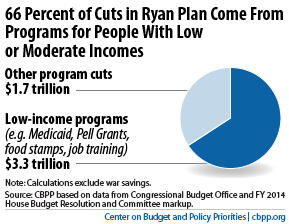BEYOND THE NUMBERS
We recently updated the percentage, below, from 66 to 72 percent, and the cuts, below, from $3.3 trillion to $3.1 trillion— and that’s because we updated our budget baseline primarily to assume that the sequestration budget cuts remain in effect.
At least 66 percent of the cuts in House Budget Committee Chairman Paul Ryan’s new budget would come from programs that serve people of limited means, our new analysis finds. That violates a core principle of the Simpson-Bowles fiscal commission, which the commission co-chairs reiterated in the revised plan they issued a few weeks ago: that deficit reduction should not increase poverty or widen inequality.

Our report has the specifics, but the $3.3 trillion in cuts fall into the following four categories:
- $2.6 trillion in reductions from Medicaid, subsidies to help people with low or moderate incomes purchase health insurance, and much smaller related expenditures under the Affordable Care Act.
- $135 billion in cuts to the Supplemental Nutrition Assistance Program (SNAP), formerly known as the Food Stamp Program.
- At least $325 billion in cuts in mandatory programs serving low-income Americans other than Medicaid and SNAP.
- At least $235 billion in cuts in low-income discretionary programs.
As our report explains, our estimates are conservative. In cases where the Ryan proposal cuts funding in a budget category but doesn’t distribute that cut among specific programs, we assume that all programs in that category — including low-income ones — will merely bear a proportionate share of the cut. But when policymakers are faced with the choice of which specific programs to cut, they likely won’t cut much from a number of the non-low-income programs in these budget categories that are popular, such as the FBI, cancer research, and protecting the borders. That means that other programs — including low-income programs — would have to be cut by more than their proportionate share.
